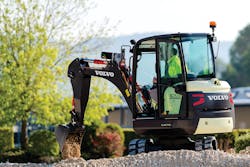Volvo CE Unveils All-Electric Compact Excavator Prototype
We previously reported on the recent introductions of a refuse truck and mini excavator that both use electric drives to power each vehicle and its hydraulic system. Eliminating the internal-combustion engine from these machines make them quieter and with zero emissions.
Volvo Construction Equipment (Volvo CE) has taken this concept to the next level with its latest concept machine, EX2. The EX2 is a100% electric compact excavator prototype incorporates an electric drive for propulsion, but also for work functions. So, yes, it uses electromechanical actuators and no hydraulics.
The EX2 was presented at the Volvo Group Innovation Summit in London, UK, alongside innovations from across the Volvo Group, including an autonomous refuse truck from Volvo Trucks and an electric bus from Volvo Buses. The innovation summit centered on infrastructure and transport in cities of the future and focused on how the industry can have a positive impact on society through increased transport efficiency, reduced environmental impact and improved traffic safety.
Electrifying Innovation
The Volvo Group defines electromobility as “commercial vehicles and machines that can utilize an electrical motor to propel or to perform the main purpose of the machine.” To make the EX2 prototype fully electric, the internal-combustion engine has been replaced with two lithium ion batteries, totaling 38. kW-hr, which store enough electric energy to operate the machine for eight hours in an intense application, such as digging compact ground.
The hydraulic system has also been replaced with electric drives that incorporate electromechanical linear actuators. Removing the hydraulic system and the gas or diesel engine reduces cooling demand and significantly reduces noise. At this time, the EX2 is purely a research project, and no plans currently exist for production.
“Volvo CE is committed to contributing to sustainable development,” said Thomas Bitter, senior vice president of marketing and product portfolio. “At Volvo CE we are developing technologies connected to electromobility, intelligent machines and total site solutions that will benefit our customers and the environment by contributing to increased machine performance, productivity, efficiency, safety and sustainability. Our future products and services will play an important part in building a sustainable society.”
Innovating for a Sustainable Future
The EX2 stemmed from the company’s earlier ELEXC research project, which was partly financed by the French government and various funding bodies in France. Volvo CE worked with a team of six partner companies which all contributed towards the €7m project. The ELEXC work started in 2012 and concluded in 2015, Volvo CE has since been working on other research projects connected to the EX2, such as durability tests.
“The electrification of construction equipment will produce cleaner, quieter and more efficient machines—this represents the future of our industry,” concludes Ahcène Nedjimi, electrics and electronics systems lead engineer and EX2 project leader. “The EX2 is a revolutionary machine. With its zero emissions and ten times lower noise levels, it could easily be used in densely populated areas without disturbing people—even at night.
“Ten times higher machine efficiency and maintenance-free systems mean that operating costs and total cost of ownership would be significantly reduced. The prototype machine delivers the same power and force as its conventional counterpart, as well as faster speeds in combined movements. And all of this has been achieved without compromising on machine performance, ensuring customer needs would be fulfilled.”


